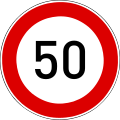
Speed limit
Speed limits on road traffic, as used in most countries, set the legal maximum speed at which vehicles may travel on a given stretch of road.[1] Speed limits are generally indicated on a traffic sign reflecting the maximum permitted speed, expressed as kilometres per hour (km/h) or miles per hour (mph) or both. Speed limits are commonly set by the legislative bodies of national or provincial governments and enforced by national or regional police and judicial authorities. Speed limits may also be variable, or in some places nonexistent, such as on most of the Autobahnen in Germany.[2]
This article is about road speed limits. For the speed of light, see Special relativity. For road speed limits in specific countries, see Speed limits by country. For rail speed limits, see Slow zone.
The first numeric speed limit for automobiles was the 10 mph (16 km/h) limit introduced in the United Kingdom in 1861.[3]
As of 2018 the highest posted speed limit in the world is 160 km/h (99 mph), applied on two motorways in the UAE.[4] Speed limits and safety distance are poorly enforced in the UAE, specifically on the Abu Dhabi to Dubai motorway – which results in dangerous traffic, according to a French government travel advisory.[5] Additionally, "drivers often drive at high speeds [and] unsafe driving practices are common, especially on inter-city highways. On highways, unmarked speed bumps and drifting sand create additional hazards", according to a travel advisory issued by the U.S. State Department.[6]
There are several reasons to regulate speed on roads. It is often done in an attempt to improve road traffic safety and to reduce the number of casualties from traffic collisions. The World Health Organization (WHO) identified speed control as one of a number of steps that can be taken to reduce road casualties.[n 1] As of 2021, the WHO estimates that approximately 1.3 million people die of road traffic crashes each year.[7]
Authorities may also set speed limits to reduce the environmental impact of road traffic (vehicle noise, vibration, emissions) or to enhance the safety of pedestrians, cyclists, and other road-users. For example, a draft proposal from Germany's National Platform on the Future of Mobility task force recommended a blanket 130 km/h (81 mph) speed limit across the Autobahnen to curb fuel consumption and carbon emissions.[8] Some cities have reduced limits to as little as 30 km/h (19 mph) for both safety and efficiency reasons.[9] However, some research indicates that changes in the speed limit may not always alter average vehicle speed.[10]
Lower speed limits could reduce the use of over-engineered vehicles.[11]
Several methods exist to set up a speed limit:[105]
For instance, the Injury Minimization (known as Safe System) method takes into account the crash types that are likely to occur, the impact forces that result, and the tolerance of the human body to withstand these forces to set speed limit. This method is used in countries such as the Netherlands and Sweden.[106]
The Operating speed method sets the maximum speed at or around the 85th percentile speed. This reduces the need to enforce the speed limit, but also allows drivers to fail to select the appropriate travel speed, when they misjudge the risk their environment induces. This is one method used in the United States of America.[106]
Effectiveness[edit]
Compliance[edit]
Speed limits are more likely to be complied with if drivers have an expectation that the speed limits will be consistently enforced.[108]
To be effective and abided by, the speed limits need to be perceived as credible; they should be reasonable regarding factors such as how well the driver can see ahead and to the sides on a particular road.[23] Speed limits also need to conform to road infrastructure, education, and enforcement activity.[23]
Technology[edit]
Some European cars include in-vehicle systems that support drivers’ compliance with the speed limit, known as intelligent speed adaptation (ISA). ISA supports drivers in complying with the speed limit in various parts of the network, while speed limiters for heavy goods vehicles and coaches only govern the maximum speed. These systems have positive effects on speed behaviour, and improve safety. A speed-limiting device, such as ISA are considered useful by 25% of European car drivers.[182] In 2019, Google Maps integrated alerts for speed traps within its application, along with audible alerts for nearby speed cameras.[183] The technology was first developed by Waze, with requests for it to be removed from the application by police officers.[184]















![United States (New York variant; "CITY", "VILLAGE", "TOWN", or a variant of the word "AREA" can be used in place of "STATE")[176]](http://upload.wikimedia.org/wikipedia/commons/thumb/e/e4/NYSDOT_NYR2-2.svg/97px-NYSDOT_NYR2-2.svg.png)

